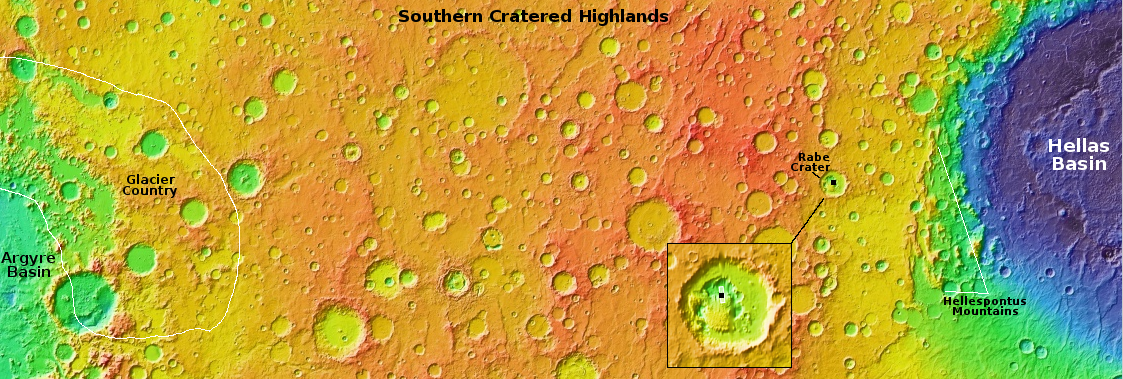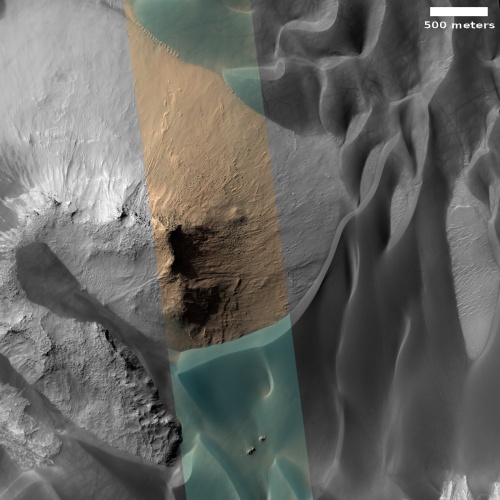Exploring the cratered southern highlands of Mars, part 2

Our travels in the cratered southern highlands of Mars continues. Today we visit 67-mile-wide Rabe Crater, as indicated on the overview map above. The picture to the right, cropped and reduced to post here, was taken on January 27, 2023 by the high resolution camera on Mars Reconnaissance Orbiter (MRO).
Rabe Crater is significant for several reasons. First, it was one of the first places on Mars where sand dunes were identified, by one of the Viking orbiters in the late 1970s [pdf]. Second, the pits and sand in its interior, are unusual and puzzling. The inset on the overview map provides a closeup look at the crater. The yellow mound in the central south of the crater floor is all dunes, which are surrounded by the pit with steep cliffs more than a 1,000 feet high.
The sudden change in color in the picture clearly shows the contact between these dunes and a section of bedrock that sticks up above them. Likely this difference is caused by the nature of the material, with the dunes made of fine-grained sand and the bedrock coarse rock.
Present theory suggests that the sand in the dunes comes from the large surrounding pit, though this is not confirmed. The pit itself is thought to have been formed by either water or glacial erosion, though neither of these theories are confirmed as well.
What is most intriguing is the lack of obvious glacial material inside Rabe Crater, even though it is located at 43 degrees south latitude, where such glacial features are common in craters, and where just a short distance to the southwest (where yesterday’s cool image was located), the ground seems completely ice covered. Possibly the crater’s high elevation plays a part, but if so why are there glacial features in other craters at the same elevations, as well as on the plains nearby? Some researchers think the impact that formed Hellas Basin might be part of the answer, though this explanation depends on so many assumptions it cannot be taken too seriously.
More on this subject tomorrow, when we visit another crater in this region with similar features.
On Christmas Eve 1968 three Americans became the first humans to visit another world. What they did to celebrate was unexpected and profound, and will be remembered throughout all human history. Genesis: the Story of Apollo 8, Robert Zimmerman's classic history of humanity's first journey to another world, tells that story, and it is now available as both an ebook and an audiobook, both with a foreword by Valerie Anders and a new introduction by Robert Zimmerman.
The print edition can be purchased at Amazon or from any other book seller. If you want an autographed copy the price is $60 for the hardback and $45 for the paperback, plus $8 shipping for each. Go here for purchasing details. The ebook is available everywhere for $5.99 (before discount) at amazon, or direct from my ebook publisher, ebookit. If you buy it from ebookit you don't support the big tech companies and the author gets a bigger cut much sooner.
The audiobook is also available at all these vendors, and is also free with a 30-day trial membership to Audible.
"Not simply about one mission, [Genesis] is also the history of America's quest for the moon... Zimmerman has done a masterful job of tying disparate events together into a solid account of one of America's greatest human triumphs."--San Antonio Express-News

Our travels in the cratered southern highlands of Mars continues. Today we visit 67-mile-wide Rabe Crater, as indicated on the overview map above. The picture to the right, cropped and reduced to post here, was taken on January 27, 2023 by the high resolution camera on Mars Reconnaissance Orbiter (MRO).
Rabe Crater is significant for several reasons. First, it was one of the first places on Mars where sand dunes were identified, by one of the Viking orbiters in the late 1970s [pdf]. Second, the pits and sand in its interior, are unusual and puzzling. The inset on the overview map provides a closeup look at the crater. The yellow mound in the central south of the crater floor is all dunes, which are surrounded by the pit with steep cliffs more than a 1,000 feet high.
The sudden change in color in the picture clearly shows the contact between these dunes and a section of bedrock that sticks up above them. Likely this difference is caused by the nature of the material, with the dunes made of fine-grained sand and the bedrock coarse rock.
Present theory suggests that the sand in the dunes comes from the large surrounding pit, though this is not confirmed. The pit itself is thought to have been formed by either water or glacial erosion, though neither of these theories are confirmed as well.
What is most intriguing is the lack of obvious glacial material inside Rabe Crater, even though it is located at 43 degrees south latitude, where such glacial features are common in craters, and where just a short distance to the southwest (where yesterday’s cool image was located), the ground seems completely ice covered. Possibly the crater’s high elevation plays a part, but if so why are there glacial features in other craters at the same elevations, as well as on the plains nearby? Some researchers think the impact that formed Hellas Basin might be part of the answer, though this explanation depends on so many assumptions it cannot be taken too seriously.
More on this subject tomorrow, when we visit another crater in this region with similar features.
On Christmas Eve 1968 three Americans became the first humans to visit another world. What they did to celebrate was unexpected and profound, and will be remembered throughout all human history. Genesis: the Story of Apollo 8, Robert Zimmerman's classic history of humanity's first journey to another world, tells that story, and it is now available as both an ebook and an audiobook, both with a foreword by Valerie Anders and a new introduction by Robert Zimmerman.
The print edition can be purchased at Amazon or from any other book seller. If you want an autographed copy the price is $60 for the hardback and $45 for the paperback, plus $8 shipping for each. Go here for purchasing details. The ebook is available everywhere for $5.99 (before discount) at amazon, or direct from my ebook publisher, ebookit. If you buy it from ebookit you don't support the big tech companies and the author gets a bigger cut much sooner.
The audiobook is also available at all these vendors, and is also free with a 30-day trial membership to Audible.
"Not simply about one mission, [Genesis] is also the history of America's quest for the moon... Zimmerman has done a masterful job of tying disparate events together into a solid account of one of America's greatest human triumphs."--San Antonio Express-News



More on Mars
https://phys.org/news/2023-04-interactive-mosaic-nasa-imagery-mars.html